Ulan-Ude
Ulan-Ude (Buryat: Улаан-Үдэ, Ulaan-Üde, [ʔʊˈlaˑɴ ʔʉˌdə]; Russian: Улан-Удэ, IPA: [ʊˈlan ʊˈdɛ]; Mongolian: Улаан-Үд, Ulaan-Üd, [ʔʊˈɮaˑɴ ˌʔʉt(tə)]) is the capital city of the Republic of Buryatia, Russia; it is located about 100 kilometers (62 mi) southeast of Lake Baikal on the Uda River at its confluence with the Selenga. According to the 2010 Census, 404,426 people lived in Ulan-Ude;[2] up from 359,391 recorded in the 2002 Census,[8] making the city the third-largest in the Russian Far East by population.
Ulan-Ude Улан-Удэ | |
|---|---|
City | |
| Other transcription(s) | |
| • Buryat | Улаан Үдэ |
Ulan-Ude City Center | |
.png) Flag  Coat of arms | |
Location of Ulan-Ude 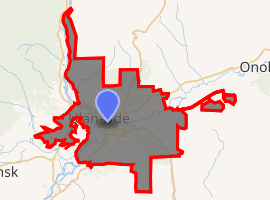
| |
 Ulan-Ude Location of Ulan-Ude .svg.png) Ulan-Ude Ulan-Ude (Republic of Buryatia) | |
| Coordinates: 51°50′N 107°36′E | |
| Country | Russia |
| Federal subject | Buryatia |
| Founded | 1666 |
| City status since | 1775 |
| Government | |
| • Body | City Council of Deputies[1] |
| • Mayor[1] | Igor Shutenkov[1] |
| Area | |
| • Total | 347.6 km2 (134.2 sq mi) |
| Elevation | 500 m (1,600 ft) |
| Population | |
| • Total | 404,426 |
| • Estimate (2018)[3] | 434,869 (+7.5%) |
| • Rank | 45th in 2010 |
| • Density | 1,200/km2 (3,000/sq mi) |
| • Subordinated to | city of republic significance of Ulan-Ude[4] |
| • Capital of | Republic of Buryatia |
| • Capital of | city of republic significance of Ulan-Ude[4] |
| • Urban okrug | Ulan-Ude Urban Okrug[5] |
| • Capital of | Ulan-Ude Urban Okrug[5] |
| Time zone | UTC+8 (MSK+5 |
| Postal code(s)[7] | 6700xx |
| Dialing code(s) | +7 3012 |
| OKTMO ID | 81701000001 |
| City Day | September's first Saturday |
| Website | ulan-ude-eg |
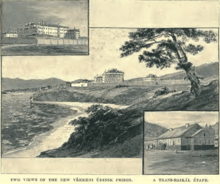
It was previously known as Udinsk (until 1783), Verkhneudinsk (until July 27, 1934).
Names
Ulan-Ude was first called Udinskoye (У́динское) for its location on the Uda River. It was founded as a small fort in 1668.[9] From around 1735, the settlement was called Udinsk (Уди́нск) and was granted town status under that name in 1775.[10] The name was changed to Verkhneudinsk, literally "Upper Udinsk" (Верхнеу́динск) in 1783, to differentiate it from Nizhneudinsk ("Lower Udinsk") lying on a different Uda River near Irkutsk which was granted town status that year.[10]
The "upper" and "lower" refer to positions of the two cities relative to each other, not the location of the cities on their respective Uda rivers. Verkhneudinsk lies at the mouth of its Uda, i.e. the lower end, while Nizhneudinsk is along the middle stretch of its Uda. The current name was given to the city 27 July 1934 and means "red Uda" in Buryat, reflecting the Soviet Union's Communist ideology.[11]
Geography
Ulan-Ude lies 5,640 kilometers (3,500 mi) east of Moscow and 100 kilometers (62 mi) southeast of Lake Baikal. It is 600 meters (2,000 ft) above sea level at the foot of the Khamar-Daban and Ulan-Burgas mountain ranges, next to the confluence of the Selenga River and its tributary, the Uda, which divides the city.[12]
Hydrography
Ulan-Ude is traversed by two rivers, the Selenga and Uda. The Selenga provides the greatest inflow to Baikal Lake, supplying 50% of all rivers in its basin. The Selenga brings into the lake about 30 cubic kilometers (7 cubic miles) of water per year, exerting a major influence on the formation of the lake water and its sanitary condition. Selenga is the habitat of the most valuable fish species such as Omul, Siberian sturgeon, Siberian taimen, Thymallus and Coregonus.
Uda is the right inflow of the Selenga river. The length of the watercourse is 467 kilometers (290 miles).
History
_(1790).png)
The first occupants of the area where Ulan-Ude now stands were the Evenks and, later, the Buryat Mongols. Ulan-Ude was settled in 1666 by the Russian Cossacks as the fortress of Udinskoye. Due to its favorable geographical position, it grew rapidly and became a large trade center which connected Russia with China and Mongolia and, from 1690, was the administrative center of the Transbaikal region.
By 1775, it was known as Udinsk, and in 1783 it was granted city status and renamed Verkhneudinsk. After a large fire in 1878, the city was almost completely rebuilt. The Trans-Siberian Railway reached the city in 1900 causing an explosion in growth. The population which was 3,500 in 1880 reached 126,000 in 1939.[13]
From 6 April to October 1920 Verkhneudinsk was the capital of the Far Eastern Republic (Дальневосточная Республика), sometimes called Chita Republic.[14] It was a nominally independent state that existed from April 1920 to November 1922 in the easternmost part of the Russian Far East. On 27 July 1934, the city was renamed Ulan-Ude. There was a War there between Reds and Whites in 1917–1924.
Administrative and municipal status
.jpg)
Ulan-Ude is the capital of the republic. Within the framework of administrative divisions, it is incorporated as the city of republic significance of Ulan-Ude—an administrative unit with the status equal to that of the districts.[4] As a municipal division, the city of republic significance of Ulan-Ude is incorporated as Ulan-Ude Urban Okrug.[5]
Demographics
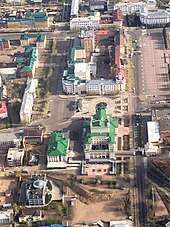
According to the 2010 Census, 404,426 people lived in Ulan-Ude;[2] up from 359,391 recorded in the 2002 Census.[8] In terms of population, it is the third-largest city in eastern Siberia.
| Year | 1923 | 1926 | 1939 | 1959 | 1970 | 1979 | 1989 | 2002 | 2010 | 2017 |
|---|---|---|---|---|---|---|---|---|---|---|
| Population | 21,600 | 28,900 | 125,700 | 174,300 | 253,600 | 299,800 | 352,530[16] | 374,854 | 404,426 | 431,922[17] |
The ethnic makeup of the city's population in 2010:[18]
- Russians: 62.1%
- Buryats: 31.9%
- Ukrainians: 0.6%
- Tatars: 0.5%
- Others: 4.9%
The city is the center of Tibetan Buddhism in Russia and the important Ivolginsky datsan is located 23 km (14 mi) from the city.
Transportation
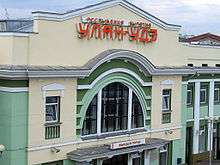
Ulan-Ude is located on the main line (Trans-Siberian line) of the Trans-Siberian Railway between Irkutsk and Chita[19] at the junction of the Trans-Mongolian line (the Trans-Mongolian Railway) which begins at Ulan Ude and continues south through Mongolia to Beijing in China.[20][21]
The city also lies on the M55 section of the Baikal Highway (part of the Trans-Siberian Highway), the main federal road to Vladivostok. Air traffic is served by the Ulan-Ude Airport (Baikal), as well as the smaller Ulan-Ude Vostochny Airport. Intracity transport includes tram, bus, and marshrutka (share taxi) lines.
Culture
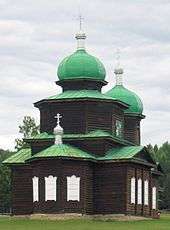
Until 1991, Ulan-Ude was closed to foreigners. There are old merchants' mansions richly decorated with wood and stone carving in the historical center of Ulan-Ude, along the river banks which are exceptional examples of Russian classicism. The city has a large ethnographic museum which recalls the history of the peoples of the region. There is a large and highly unusual statue of the head of Vladimir Lenin in the central square: the largest in the world. Built in 1970 for the centennial of Lenin's birth, it towers over the main plaza at 7.7 meters (25 ft) and weighs 42 tons.[22]
Sights
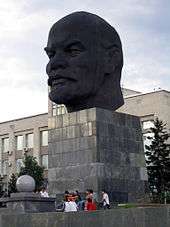
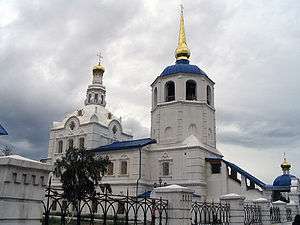
The Ethnographic Museum of the peoples of Transbaikal is one of Russia's largest open-air museums. The museum contains historical finds from the era of the Slab Grave Culture and the Xiongnu until the mid 20th century, including a unique collection of samples of wooden architecture of Siberia – more than forty architectural monuments.
Odigitrievsky Cathedral – Orthodox Church Diocese of the Buryat, was the first stone building in the city and is a Siberian baroque architectural monument. The cathedral is considered unique because it is built in a zone of high seismic activity in the heart of the city on the banks of the River Uda River where it flows into the Selenga.
One of the attractions of Ulan-Ude is a monument in the town square — the square of the Soviets — in the form of the head of Lenin (sculptors G.V. Neroda, J.G. Neroda, architects Dushkin, P.G. Zilberman). The monument, weighing 42 tons and with a height of 7.7 meters (25 ft), was opened in 1971 in honor of the centenary of Lenin's birth.[22] The Voice of Nomads international music and culture festival is held annually at various sites in the city.
Climate
Ulan-Ude can be described as possessing a humid steppe climate (Köppen climate classification BSk), bordering on a humid continental climate (Dwb borders on Dwc). The climate is characterised by long, dry, cold winters and short but very warm summers. Precipitation is low and heavily concentrated in the warmer months.
| Climate data for Ulan-Ude, 1981–2010 normals, extremes 1892–present | |||||||||||||
|---|---|---|---|---|---|---|---|---|---|---|---|---|---|
| Month | Jan | Feb | Mar | Apr | May | Jun | Jul | Aug | Sep | Oct | Nov | Dec | Year |
| Record high °C (°F) | −0.4 (31.3) |
7.9 (46.2) |
18.4 (65.1) |
28.7 (83.7) |
35.6 (96.1) |
40.0 (104.0) |
40.6 (105.1) |
39.7 (103.5) |
32.2 (90.0) |
24.7 (76.5) |
11.3 (52.3) |
5.2 (41.4) |
40.6 (105.1) |
| Average high °C (°F) | −17.9 (−0.2) |
−10.9 (12.4) |
−0.3 (31.5) |
9.8 (49.6) |
18.7 (65.7) |
24.5 (76.1) |
26.6 (79.9) |
23.6 (74.5) |
16.5 (61.7) |
6.9 (44.4) |
−5.0 (23.0) |
−14.5 (5.9) |
6.5 (43.7) |
| Daily mean °C (°F) | −23.3 (−9.9) |
−18.0 (−0.4) |
−7.4 (18.7) |
2.4 (36.3) |
10.6 (51.1) |
16.9 (62.4) |
19.8 (67.6) |
17.1 (62.8) |
9.6 (49.3) |
0.7 (33.3) |
−10.1 (13.8) |
−19.3 (−2.7) |
−0.1 (31.8) |
| Average low °C (°F) | −27.6 (−17.7) |
−24.0 (−11.2) |
−13.7 (7.3) |
−3.7 (25.3) |
3.6 (38.5) |
10.5 (50.9) |
14.2 (57.6) |
11.8 (53.2) |
4.3 (39.7) |
−4.0 (24.8) |
−14.3 (6.3) |
−23.2 (−9.8) |
−5.5 (22.1) |
| Record low °C (°F) | −54.4 (−65.9) |
−44.9 (−48.8) |
−40.4 (−40.7) |
−28.0 (−18.4) |
−15.1 (4.8) |
−3.9 (25.0) |
1.2 (34.2) |
−4.0 (24.8) |
−11.4 (11.5) |
−27.9 (−18.2) |
−38.0 (−36.4) |
−48.8 (−55.8) |
−54.4 (−65.9) |
| Average precipitation mm (inches) | 5 (0.2) |
3 (0.1) |
3 (0.1) |
6 (0.2) |
18 (0.7) |
43 (1.7) |
65 (2.6) |
68 (2.7) |
28 (1.1) |
8 (0.3) |
10 (0.4) |
9 (0.4) |
265 (10.4) |
| Average rainy days | 0 | 0.04 | 1 | 6 | 10 | 14 | 16 | 15 | 13 | 7 | 1 | 0 | 83 |
| Average snowy days | 15 | 11 | 9 | 8 | 2 | 0.03 | 0 | 0 | 1 | 8 | 17 | 18 | 89 |
| Average relative humidity (%) | 77 | 75 | 66 | 53 | 49 | 57 | 64 | 69 | 68 | 68 | 76 | 78 | 67 |
| Mean monthly sunshine hours | 115 | 155 | 225 | 248 | 287 | 288 | 270 | 247 | 211 | 167 | 113 | 92 | 2,418 |
| Source 1: Погода и Климат[23] | |||||||||||||
| Source 2: NOAA[24] | |||||||||||||
Notable people
- Irina Pantaeva, Sports Illustrated model
- Oksana Omelianchik, artistic gymnast
- Dmitry Masleev, pianist
- Alexander Slastin, actor
- Inna Stepanova, Olympic archer
Twin towns - sister cities
Ulan-Ude is twinned with:[25]



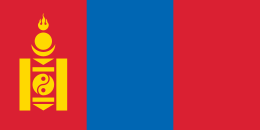

















References
| Wikivoyage has a travel guide for Ulan-Ude. |
Notes
- "Baikal24".
- Russian Federal State Statistics Service (2011). "Всероссийская перепись населения 2010 года. Том 1" [2010 All-Russian Population Census, vol. 1]. Всероссийская перепись населения 2010 года [2010 All-Russia Population Census] (in Russian). Federal State Statistics Service.
- "26. Численность постоянного населения Российской Федерации по муниципальным образованиям на 1 января 2018 года". Federal State Statistics Service. Retrieved January 23, 2019.
- Resolution #431
- Law #985-III
- "Об исчислении времени". Официальный интернет-портал правовой информации (in Russian). June 3, 2011. Retrieved January 19, 2019.
- Почта России. Информационно-вычислительный центр ОАСУ РПО. (Russian Post). Поиск объектов почтовой связи (Postal Objects Search) (in Russian)
- Russian Federal State Statistics Service (May 21, 2004). "Численность населения России, субъектов Российской Федерации в составе федеральных округов, районов, городских поселений, сельских населённых пунктов – районных центров и сельских населённых пунктов с населением 3 тысячи и более человек" [Population of Russia, Its Federal Districts, Federal Subjects, Districts, Urban Localities, Rural Localities—Administrative Centers, and Rural Localities with Population of Over 3,000] (XLS). Всероссийская перепись населения 2002 года [All-Russia Population Census of 2002] (in Russian).
- Chisholm, Hugh, ed. (1911). . Encyclopædia Britannica. 27 (11th ed.). Cambridge University Press. p. 1023.
- "Ulan-Ude – a Russian center of Buddhism". Sputnik News Agency: The Voice of Russia. February 8, 2011. Archived from the original on August 13, 2016. Retrieved August 13, 2016.
In 1783 the name was changed, yet again, to Verkhneudinsk, which literally means "Upper Udinsk". This name change was made to set it apart from Nizhneudinsk (or Lower Udinsk). Naturally, the "upper" and "lower" refer to positions of the two cities relative to each other, not the location of the cities on their respective Uda River.
- "The Great Journey – East to West". April 25, 2017 – via expresstorussia.com.
- transsibirskaya.com
- britannica.com
- Bisher, Jamie (June 2005). White Terror: Cossack Warlords of the Trans-Siberian. pp. 302–03. ISBN 9781135765958.
- "Исторические предпосылки формирования современной этнической структуры г.Улан-Удэ". Ethonet.ru. Archived from the original on February 13, 2012. Retrieved April 17, 2018.
- "Всесоюзная перепись населения 1989 г. Численность наличного населения союзных и автономных республик, автономных областей и округов, краёв, областей, районов, городских поселений и сёл-райцентров" [All Union Population Census of 1989: Present Population of Union and Autonomous Republics, Autonomous Oblasts and Okrugs, Krais, Oblasts, Districts, Urban Settlements, and Villages Serving as District Administrative Centers]. Всесоюзная перепись населения 1989 года [All-Union Population Census of 1989] (in Russian). Институт демографии Национального исследовательского университета: Высшая школа экономики [Institute of Demography at the National Research University: Higher School of Economics]. 1989 – via Demoscope Weekly.
- "2017". July 27, 2018.
- "Russian Census 2010" (PDF). July 27, 2018.
- Train Ulan Ude – Irkutsk Archived January 26, 2013, at the Wayback Machine
- /realrussia.co.uk
- transsiberianexpress.net
- Памятник В. И. Ленину (in Russian). Monulent.ru. Retrieved April 17, 2018.
- "Climate Ulan-Ude". Pogoda.ru.net. Retrieved May 15, 2019.
- "ULAN-UDE/MUHINO 1961–1990". NOAA. Retrieved May 15, 2019.
- "Города-побратимы". ulan-ude-eg.ru (in Russian). Ulan-Ude. Retrieved February 1, 2020.
Sources
- Правительство Республики Бурятия. Постановление №431 от 18 ноября 2009 г. «О реестре административно-территориальных единиц и населённых пунктов Республики Бурятия», в ред. Постановления №573 от 13 ноября 2015 г. «О внесении изменений в Постановление Правительства Республики Бурятия от 18.11.2009 №431 "О реестре административно-территориальных единиц и населённых пунктов Республики Бурятия"». Вступил в силу 18 ноября 2009 г. Опубликован: "Бурятия", №216, Официальный вестник №120, 21 ноября 2009 г. (Government of the Republic of Buryatia. Resolution #431 of November 18, 2009 On the Registry of the Administrative-Territorial Units and the Inhabited Localities of the Republic of Buryatia, as amended by the Resolution #573 of November 13, 2015 On Amending Resolution #431 of November 18, 2009 of the Government of the Republic of Buryatia "On the Registry of the Administrative-Territorial Units and the Inhabited Localities of the Republic of Buryatia". Effective as of November 18, 2009.).
- Народный Хурал Республики Бурятия. Закон №985-III от 31 декабря 2004 г. «Об установлении границ, образовании и наделении статусом муниципальных образований в Республике Бурятия», в ред. Закона №1411-V от 14 октября 2015 г. «О внесении изменений в Закон Республики Бурятия "Об установлении границ, образовании и наделении статусом муниципальных образований в Республике Бурятия"». Вступил в силу со дня официального опубликования. Опубликован: "Бурятия", №1, Официальный вестник №1, 12 января 2005 г. (People's Khural of the Republic of Buryatia. Law #985-III of December 31, 2004 On Establishing the Borders, Creating, and Granting a Status to the Municipal Formations in the Republic of Buryatia, as amended by the Law #1411-V of October 14, 2015 On Amending the Law of the Republic of Buryatia "On Establishing the Borders, Creating, and Granting a Status to the Municipal Formations in the Republic of Buryatia". Effective as of the day of the official publication.).
External links
- Ulan-Ude at the Encyclopædia Britannica
